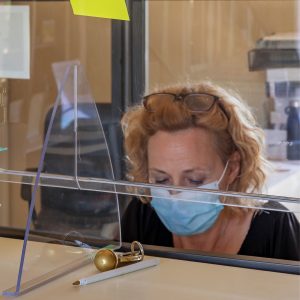As COVID vaccinations have taken hold worldwide, companies are once again contemplating strategies for in-office operations. Although all of us are relieved, certain apprehensions are not easy to overcome.
Employees may be glad to return to everyday life, but fears of contracting the virus due to public exposure still rule. Amid such conflicting situations, how can your company prepare to safeguard employees once they resume in-office operations?
Related: Reopening Your Business After COVID-19
1. Reduce Seating Capacity
In cellular offices (where each office is an enclosed space), reducing seating capacity to one and discouraging face-to-face meetings will help to prevent the spread of the virus by limiting contact and interaction. To support these initiatives, consider installing table top protection screens, as well as executive lounge chairs for those who prefer spending more time in the open areas at work. With planters and executive lounges, you can provide a feeling of calmness and well-being to your employees while restricting exposure.
2. Introduce Modular Stations, and Booths
Minimizing face-to-face mingling as much as possible, while also driving productivity, can be a challenge. “Hives” and modular stations help employees continue working efficiently while distancing themselves from others. These are easy to install, and will still provide acoustic and visual privacy. In addition, consider the option of video conferencing booths. With protective materials like anti-microbial vinyl or acoustic fabric, you can make video conferencing booths as germ-free as possible, and provide employees with private, enclosed spaces.
3. Install Vendors for Temperature and Symptom Checks
Employers must do everything possible to keep their employees safe, and one effective way of doing this is through daily screening. Set up stations at the office entrances and make it mandatory to run symptom and temperature checks every morning for each employee. This will help to prevent those who may be carrying the virus from transmitting it to other employees.
Also, set up vendors where you have testing and vaccination facilities available. Doing so will not only ensure your company’s compliance with local laws, but successfully curb the spread. Specialists are producing several materials to assist offices in implementing strict safety protocols.
4. Desktop Protection Screens
Many offices may not have the facility to stagger shifts or place their workspaces side by side. If this is the case, desktop protection screens are imperative. You can select from antibacterial and freestanding glass screens, or choose other varieties for providing adequate protection to the employee.
5. Install Signage at Your Entrances and Exits
You should consider setting up “one-way only” points for your office entrances and exits. In a similar fashion to retail locations, such as grocery stores, this change in how foot traffic is managed will help to maintain social distancing and reduce the potential for exposure. For this, clear signage (including floor options) is effective. Invest in directional arrow signage on office floor screens at intervals in your office.
Related: Setting up Your Salon With Safety Signage
6. Install Hot Taps for Coffee and Tea
Taking away the tea or coffee grounds for reducing exposure may not be possible. Since most employees need a daily dose of caffeine to kick-start their productivity, it would be unfair to deprive them of that. But you can still curb the potential contamination by sticking to a safer alternative for your employees: the hot tap. Many manufacturers provide these as a substitute for kettles because hot taps are more hygienic – they can sterilize and clean utensils and spoons quicker than your average coffee and tea maker.
Material for Promoting Safety and Combating the Spread of COVID-19
Once the business world came to terms with the pandemic’s magnitude and adopted all protocols, they shifted attention to producing materials to combat the spread. Here are some materials employers should turn to and encourage their staff members to use:
- 3-D printers for making plastic components for face shields
- Elastic polymer
- Floor markings and signage
- Hand sanitization stations
- Probe single door PPE lockers
- Protection screens for desktops
- Freestanding rooms, pods, and cells
- Video conferencing booths
- Three-way, antibacterial screens in plexiglass, glass, and acrylic materials
- “Hives” and modular workstations, such as honeycomb booths
- Hot taps
- Swing tables
- Vinyl and performance fabrics to put on new or existing upholstery
- Acoustic phone boxes or phone booths
Related: Questions for Sourcing PPE
Final Thoughts
While companies are striving to return to in-office operations, employers must ensure that they install every material possible for reducing the risk of contamination. From protection screens, to antibacterial and high-performance fabrics, to honeycomb booths, there are many options to consider for safeguarding employee health as they resume office work. For months, Ironmark has been producing safety signage and PPE materials to help businesses reopen and maintain safety. If you need materials for your location, get in touch today, and we’ll be happy to help.



